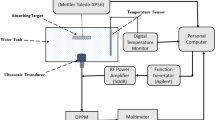Abstract
The ions of solutions exposed to the propagation of ultrasound in the presence of a magnetic field experience Lorentz force. Their movement gives rise to a local electric current density, which is proportional to the electric conductivity of the medium. In vitro assessment of this current is performed using simple models of biological media. A constant magnetic field of 0.35T and 500kHz pulsed ultrasound are used. The sensing electrodes are exposed to neither the pressure wave nor the magnetic field, thus ensuring that the signal is not due to any undesirable electrode effect. The experimental results confirm that the current is proportional to the electrical conductivity of the medium. The changes in the measured current against the width of the measurement chamber show that the electrodes only collect fraction of the current created within the medium. The magnitude of the measured current is 50nA in a saline solution of 0.5S/m conductivity. The technique enabled the determination of the conductivity of a porcine blood sample against haematocrit. It is concluded that this type of measurement has the potential to allow the electrical conductivity of a medium to be determined using ultrasound.
Similar content being viewed by others
Abbreviations
- a :
-
distance of a fluid element from its equilibrium position (m)
- B :
-
magnetic induction (T)
- c :
-
celerity of ultrasound (m.s−1)
- C :
-
molar concentration (mol.m−3)
- C m :
-
membrane capacity (F.m−2)
- dQ :
-
elementary charge (C)
- dS :
-
surface element (m2)
- dt :
-
time intervals (s)
- d τ :
-
volume element (m3)
- f :
-
ultrasound frequency (Hz)
- F :
-
molar charge, 1 faraday (96487 C.mol−1)
- i(t) :
-
electric current (A)
- I :
-
magnitude of the instantaneous current (A)
- j :
-
base of imaginary numbers
- j y :
-
current density along axis Oy (A.m−2)
- J :
-
magnitude of the instantaneous current density (A.m−2)
- m :
-
ionic mass (kg)
- M :
-
molar mass of a solvated ion (kg.mol−1)
- n :
-
ionic charge
- q :
-
electric charge (C)
- q e :
-
electron charge (1.602 10–19 C)
- r :
-
radius of a cell (m)
- t :
-
time (s)
- p :
-
instantaneous acoustic pressure (Pa)
- P :
-
magnitude of the acoustic pressure (Pa)
- u y ,u z :
-
instantaneous ionic speed along axes Oy, Oz, respectively (m.s−1)
- U y ,U z :
-
magnitude of ionic speed along axes Oy, Oz, respectively (m.s−1)
- v z :
-
instantaneous speed of a fluid element along axis Oz (m.s−1)
- V z :
-
magnitude of the speed of a fluid element (m.s−1)
- x, y, z :
-
Cartesian co-ordinates
- μ:
-
ion mobility (m2.s−1. V−1)
- σ:
-
mass density (kg.m−3)
- σ:
-
electric conductivity (S.m−1)
- σ1 :
-
electric conductivity of the interior of erythrocytes (S.m−1)
- σp :
-
electric conductivity of plasma (S.m−1)
- ϕ:
-
volume concentration of the particles in a suspension
- Ψ:
-
phase angle (rd)
- ω:
-
angular frequency (rd.s−1)
References
Cataldo, F. (1997): ‘Effects of ultrasound on the electrolytic conductivity of simple halide salts’,J Electroanal. Chem.,431, pp. 61–65
Cole, K. S. (1941): ‘Impedance of single cells’,Tabulae Biologice,19, pp. 24–27
Cole, K. S. (1972): ‘Membrane capacity’ in ‘Membranes, ions and impulses’ (University of California Press, Los Angeles), Part 1, pp. 6–113
Debye, P. (1933): ‘A method for the determination of the mass of electrolytic ions’,J. Chem. Phys.,1, pp. 13–16
Eyraud, C., Thomasset, A., Lille, R., andBerthe, D. (1967): ‘Caractérisation, par méthode électrique, d'un suspensoïde capacitif. Application à un milieu d'hématies de sang humain’,Acad. Sci. Paris,265, pp. 508–511
Fox, F., Herzfeld, K. F., andRock, G. D. (1946): ‘The effect of ultrasonic waves on the conductivity of salt solutions’,Phys. Rev.,70, pp. 329–339
Fry, W. (1968): ‘Electrical stimulation of brain localized without probes — Theoretical analysis of a proposed method’,J. Acoust. Soc. Am.,44, pp. 919–931
Giriuniene, R., andGarska, E. (1997): ‘The influence of ultrasound on electrical conductivity of water’,Ultragarsas,2, pp. 25–27
Jossinet, J., Lavandier, B., andCathignol, D. (1998): ‘The phenomenology of acousto-electric interaction signals in aqueous solutions of electrolytes’,Ultrason.,36, pp. 607–613
Lavandier, B., Jossinet, J., andCathignol, D. (2000): ‘Quantitative assessment of ultrasound-induced resistance change in saline solution’,Med. Biol. Eng. Comput.,38, pp. 150–155
Millner, R., andMüller, H. D. (1966): ‘Zum Debye-Effekt in Iönenlösungen’,Ann. Phys.,17, pp. 160–165
Pauly, H. (1959): ‘Electrical conductance and dielectric constant of the interior of erythrocytes’,Nature,183, pp. 333–334
Pethig, R. (1984): ‘Dielectric properties of biological materials: Biophysical and medical applications’,IEEE Trans. Electr. Insul.,EI-19, pp. 453–474
Rabah, H., Prieur, G., Rouané, A., Kourtiche, D., Hedjiedj, A., andBarritault, L. (1994): ‘Interaction des champs électriques et acoustiques: approche mathématique et premiers résultats expérimentaux acoustiques: approche mathématique et premiers résultats expérimentaux pour une application éventuelle en stimulation transcutanée’,Innov. Tech. Biol. Méd.,15, pp. 49–59
Rosenfeld, E. H. (1992): ‘Ultrasonic vibrational potentials in gels and preparations of biological tissue’,Ultrasound Med. Biol.,18, pp. 607–615
Roth, B. J., Basser, P. J., andWikswo, J. P. (1994): ‘A theoretical model for magneto-acoustic imaging of bioelectric currents’,IEEE Trans.,BME-41, pp. 723–728
Towe, C., andIslam, M. R. (1998): ‘A magneto-acoustic method for the noninvasive measurement of bioelectric currents’,IEEE Trans.,BME-35, pp. 892–894
Wells, P. N. T. (1977): ‘Longitudinal waves’ in ‘Biomedical ultrasonics’ (Academic Press, London), Chap. I, ‘Wave fundamentals’, pp. 3–25
Wen, H., Shah, J., andBalaban, R. S. (1997): ‘An imaging method using the interaction between ultrasound and magnetic field’, Proc. IEEE Ultrasonics Symp., pp. 1407–1410
Wen, H., Shah, J., andBalaban, R. S. (1998): ‘Hall effect imaging’,IEEE Trans.,BME-45, pp. 119–124
Author information
Authors and Affiliations
Corresponding author
Rights and permissions
About this article
Cite this article
Montalibet, A., Jossinet, J., Matias, A. et al. Electric current generated by ultrasonically induced Lorentz force in biological media. Med. Biol. Eng. Comput. 39, 15–20 (2001). https://doi.org/10.1007/BF02345261
Received:
Accepted:
Issue Date:
DOI: https://doi.org/10.1007/BF02345261




